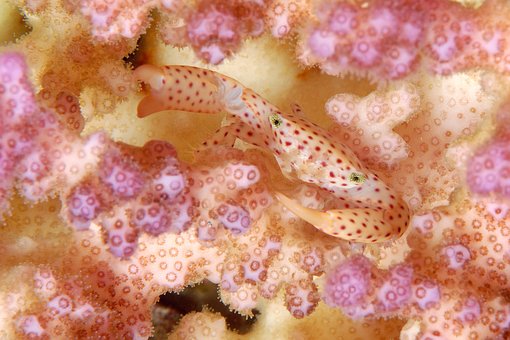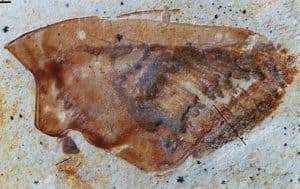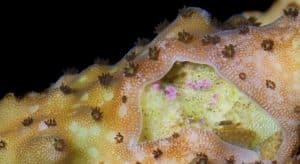Flatworms are common microorganisms found in freshwater and saltwater aquariums. Planaria is just another name to describe the flatworms. According to their effect in the aquarium, flatworms can be either benign or problematic. If you are having nuisance flatworms, you should take steps to get rid of them. To remove flatworms you can adopt natural, mechanical, and chemical treatments.
Quarantining the new corals, nurturing natural predators like Six Line Wrasse, siphoning and vacuuming flatworms from the coral surface, using chemical treatments like Flatworm Exit are some of the effective ways you can try to get rid of flatworms from your reef tank.
Note that many common species of flatworms do not affect our aquarium much. But, those are not the types we are going to talk about today. When we say how to get rid of flatworms in a reef tank, we usually mean to control those flatworms that we no longer desire to see in our aquarium.
In this article, I am going to identify some harmful flatworms and suggest ways to get rid of them from your reef tank. Let’s go ahead.

Unwanted Flatworm Types
Let’s get to know the two most distinct types of nuisance flatworms that you might encounter in your home aquarium.
Rust Brown Flatworm
 This is one of the most common nuisance flatworms found in reef tanks. This flatworm is scientifically known as Convolutriloba retrogemma. It is tan, brown, or rust when it comes to color.
This is one of the most common nuisance flatworms found in reef tanks. This flatworm is scientifically known as Convolutriloba retrogemma. It is tan, brown, or rust when it comes to color.
You can usually identify a rust-brown flatworm by seeing a red dot that goes down to its body covering a significant part. To describe its shape, it is somewhat elongated and oval. It can grow rapidly in the aquarium especially in nutrient-rich reef tanks.
If it gets a favorable atmosphere and grows unchecked, it can cover the surface of the corals and prevent them to get adequate lights. As a result, the corals can start to starve out.
Some experts opine that this type of flatworm consumes the zooxanthellae from the surface of the corals and thus damages them to the core.
You can trace it either in those areas of the tank that have low water circulation or at the coral surface.
Acropora-Eating Flatworm
 This type of flatworm has started to be more prevalent in the USA of late. This flatworm is more aggressive. Living on Acropora sp. Corals, this flatworm grows quite rapidly.
This type of flatworm has started to be more prevalent in the USA of late. This flatworm is more aggressive. Living on Acropora sp. Corals, this flatworm grows quite rapidly.
Acropora-Eating Flatworm comes in an oval shape and either in opaque or white color. The color makes it difficult to identify them in a display aquarium.
It targets the species of Acropora with shorter polyps. You can most probably find Acropora-Eating Flatworms in Tricolor species and Staghorn types.
You can recognize the presence of Acropora-Eating Flatworm when you detect rapid tissue loss of Acropora corals. On top of that, brown or gold eggs on the coral skeletons also denote the presence of it.
As Acropora-Eating Flatworm is very invasive, you should take immediate action as soon as you notice it in your reef tank.
How to Get Rid of Flatworms in a Reef Tank?
Maintaining a low nutrient level in the water with aggressive protein skimming can help you to keep the flatworms in check. Increased water flow throughout the tank also helps to control the flatworm population.
If you take no action, you’ll soon discover that the invasive flatworms are overrunning the corals. There are several approaches you can choose to remove flatworms in a reef tank. Let’s get to know some effective ways to control the flatworms in the aquarium.
-
Quarantine the New Corals
Preventing the flatworms to enter into the tank is the best way to control the infestation.
Newly-brought corals can introduce flatworms in your reef tank. It would be wise to quarantine the new corals as you quarantine new fish. It will help to keep your tank safe from the potential flatworms that might be carried by the new corals with them.
While the new corals are quarantined, keep a careful look at them and see if they have any flatworm infestation. If you can discover the harmful flatworms during the quarantine period, it would be way easier to treat and eliminate the flatworms from the corals.
-
Introduce Natural Flatworm Predators
If you can include certain types of natural flatworm predators, you can reduce the number of harmful flatworms to some extent. Here is a list of some flatworm eaters that you can nurture in your reef tank that will consume the flatworms:
- The Blue Velvet Nudibranch (very effective, but has a short life with sensitivity to the changes of water chemistry)
- Halichoeres Wrasse
- Leopard Wrasse
- Spotted Mandarin
- Six Line Wrasse
- Yellow Wrasse, etc.
Note that, nurturing the natural predators in your reef tank does not mean that they will consume every flatworm they find in front of them. Some flatworms will still be there and you will need to adopt other ways to get rid of those flatworms.
However, to get the best out of the natural predators you need to make sure that your tank has the appropriate atmosphere for them to survive and do their job.
-
Perform a Brief Freshwater Bath or Dip
Performing a brief freshwater bath can help you remove flatworms from an affected colony. This method works best to destroy the small flatworms. Flatworms find it hard to cope with changes in salinity. Here’s how to perform a freshwater bath for a short period:
- Find the infected colony out and dip that into the dechlorinated freshwater.
- Keep it submerged at that position for 5 to 10 seconds.
- Shake the colony so that the flatworms fall off into the freshwater container.
When you dip the entire colony of flatworms in dechlorinated freshwater for about 5 to 10 seconds, they start to lose their grip. What you need to do is to shake them off while you have submerged them in the freshwater. Once you are done, you will see that the flatworms have fallen flat at the bottom of the container.
However, make sure that the freshwater you are using has the same pH level and temperature as the reef tank. Otherwise, the freshwater will increase the stress on the colony.
Keeping the colony underwater for an extended period can harm the sensitive corals. So, avoid dipping the colony underwater for longer than 10 seconds.
-
Remove the Flatworms with the Manual Process
Siphoning is one of the most effective ways to remove the flatworms from the reef tank. Siphoning works because the flatworms (especially the Rust Brown flatworms) have a very loose grip on the colony.
Manage a small (¼” airline) siphon and start siphoning the problematic areas.
When you are done with siphoning, gently vacuum the flatworms out of the coral surface. Keep the tube away from the surface of the corals while you are doing that.
-
Apply Chemical Treatments
Some chemical products work well against harmful flatworms in the reef tank. Salifert’s Flatworm Exit™ is one of the most talked-about flatworm treatment chemicals with good ratings. You can also try Blue Life USA Flatworm Rx or AquaMaxx ROX 0.8 Carbon Filter Media to remove the flatworms.
If you choose to apply chemical treatment in your reef tank, make sure that you siphon out the dead flatworms from the tank. Dead flatworms are very toxic and destroy water chemistry.
Using chemical treatments is the quickest way to get rid of flatworms. While you adopt any of the chemical treatments mentioned above, you have to follow the procedures mentioned by the manufacturer very carefully. You might need to go through water changes as well after applying the chemical treatments.
-
Go for Long Term Solutions
Keeping a careful look at the reef tank, quarantining the new rocks, maintaining a low level of phosphates and nitrates are some of the ways that can help keep the reef tank away from flatworms.
Final Thoughts
Nuisance flatworms are harmful when they are alive and toxic when they die. Removing them from the saltwater or reef tank is quite a complex task. You might need to adopt more than one approach mentioned above to bring the normal atmosphere in your reef tank once again.
We hope that now you know enough information about how to get rid of flatworms in saltwater tank. Remember that it is always better to prevent the flatworms from getting into the tank and affecting your corals than fighting to get rid of them again and again throughout the year.
